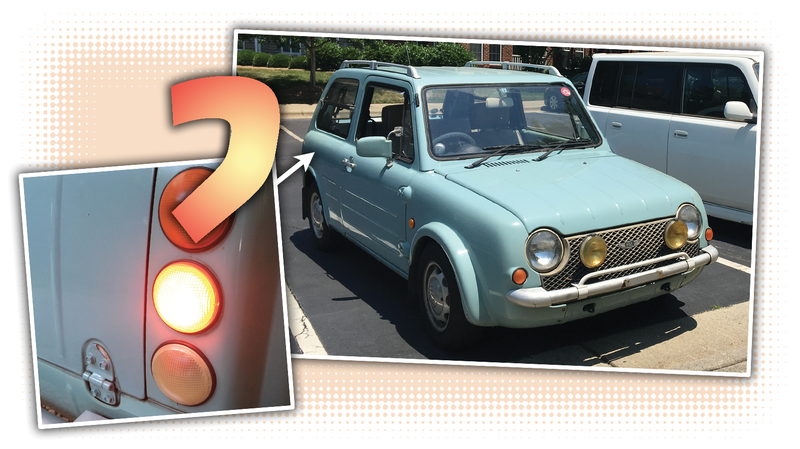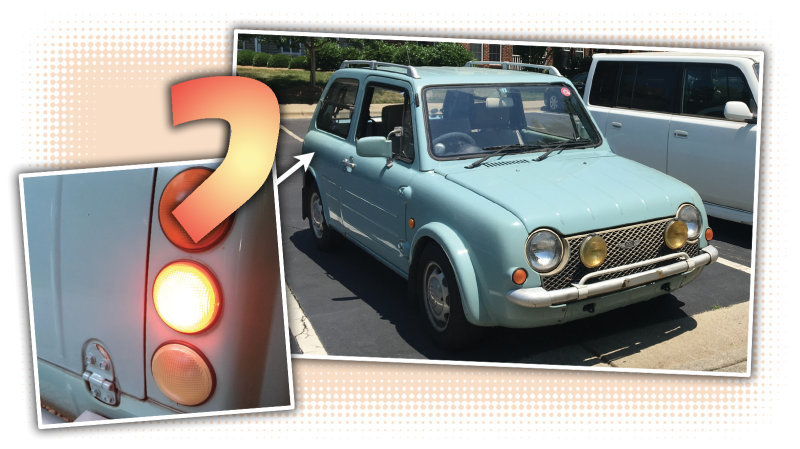
Overall, my 1990 Nissan Pao has been one of the most reliable cars I’ve owned. While it looks charming and unusual and funky, the guts of the car are all from the very rational Nissan Micra, a popular city car all over the world, well, except for America. That’s why I was so surprised about this seemingly minor but significant issue I had with the car, and even more baffled by the cause, which, as you’ll see, make no freaking sense. Hear me out.
So, I’ve been gone for about a week to South America, where I drove a Mini on the Panamerican highway and had some adventures, more of which you’ll hear about soon. While I was gone, my wife was driving the Pao around, because, face it: it’s a lot of fun and (I’m biased, sure) she looks fantastic in it.
So, she’s driving it around with our kid and doing the usual life stuff, but the day before I got back, when she parked the car, she noticed the taillights were still on. She checked all the switches and everything seemed off. It made no sense.
The fusebox cover is all in Japanese, so she didn’t know what fuse to pull, so she just had to park it and let the battery get drained flat from those misbehaving lights.
Advertisement
When I got back, I thought I knew the issue; there’s a hidden switch for the foglamps between the seats that also actuates the parking lights and taillights; I figured maybe that was on and no one knew to look for it, which would be reasonable.
But that wasn’t the case. The switch was off, and when I got the battery charged up again, I could see just the taillights were on. No parking lights up front, so it couldn’t be that. I checked all the wiring for bare insulation or points where something may be getting grounded, but no luck. Everything looked fine.
Advertisement
Then I noticed that the taillights seemed a bit brighter than I’d expect, which made me realize it was the brake lights that were on! Okay, that at least narrows it down. I pulled the brake light fuse to confirm, and yes, it’s the brake lights.
Okay, so, why? My first thought was the brake light switch. I crawled under the dash and found the switch. I unplugged it, and the lights went out. That confirmed it was switch-related. I pushed the pedal back and pushed the little brake switch plunger with my finger. Otto, my seven-year-old, confirmed the brake lights went out. The switch worked fine.
What the hell was going on?
The switch turns the brake lights off when pressed, so it must not be getting pressed, somehow? I was stumped, until I found this on the floormat:
Advertisement
What is that? A mint? A quick taste-test disproved that theory. Then, on a hunch, I got under the dash again and took a better look at the brake pedal:
Holy shit. Or, more accurately if reversed, shit, a hole! There’s a hole right where that bracket on the pedal would make contact with the brake light switch on the left to press it in, and turn the brake lights off!
Advertisement
I took the intact front part of that green thing I found on the floormat and stuck it in the hole:
Yep, that did it. The brake light switch is actuated by that plastic plug.
But why?
This is where I get completely stumped: why the hell would Nissan design this part like that? If they just had that bracket with no hole and no plug, it would be pretty much indestructible: the flat metal part of that bracket would make contact with the switch and it would all be fine.
Advertisement
So why do more work by making a part with a hole that requires an extra part, that plastic plug, which just introduced a point of failure, like I just experienced?
I had David go peek at what was in his Cherokee, just to see if this was somehow a common thing, and, as I suspected, he didn’t have any plug.
Advertisement
See, it’s just the metal of the pedal’s rod that directly presses the switch. Why wasn’t it like that on the Pao? David suggested that maybe it was to provide tool access to something behind it, but I really couldn’t see what that might be.
I’m absolutely baffled by this. I reached out to Nissan in the very unlikely event some engineer in Japan who worked on brake light actuators for Micra-class cars might be able to answer this for me. Amazingly, I got a response:
The answer is alarmingly simple!
That brake pedal, with associated bracket, has many applications beyond the PAO. The Pike cars are all low production, so the use of common parts kept the costs in line.
Advertisement
So, on some other car, that hole must make some sense. Maybe it is needed for tool access to get at some hard-to-reach part behind the pedal. On the Pao, though, it’s just weird. Nissan’s engineers also told me that, on other cars,
It would either hold the switch, from the backside, or hold a different size actuator, (the green part), to reach the switch.
I suppose the lesson here is that even in a rational machine like a mass-produced car, designed by competent professionals, there’s reasons why a given part may be, for some of its applications, be not necessarily the best-designed part it could be.
Advertisement
Money and volume are hidden factors in why your car is designed the way it is, and those factors may not give a brace of BMs about what actually makes the most sense. Like this weird little green plug.













